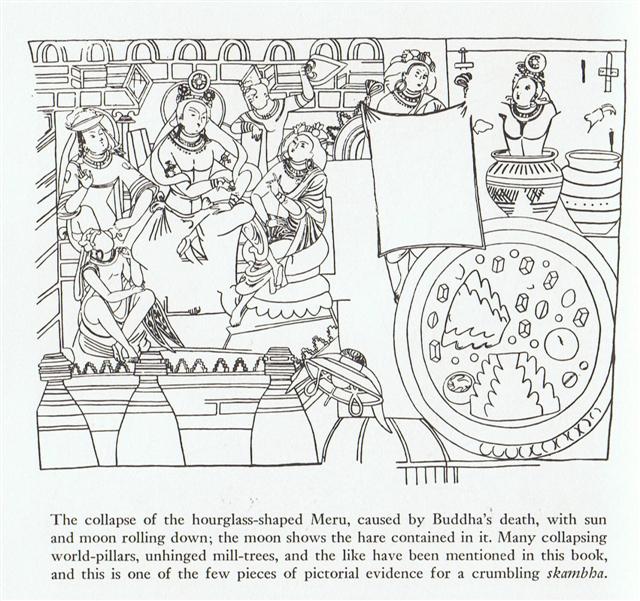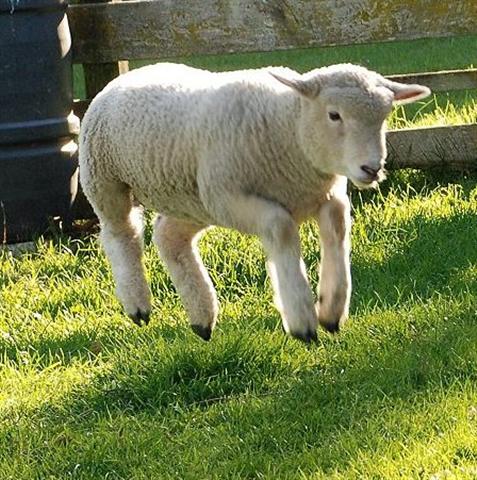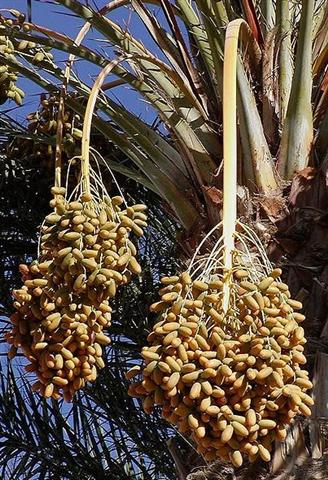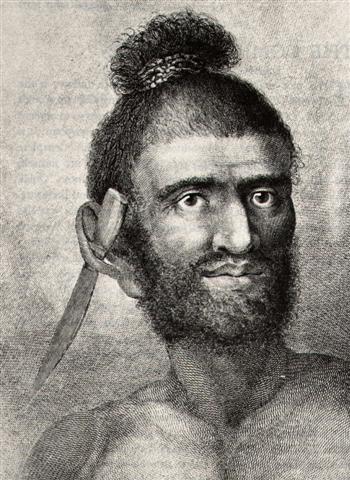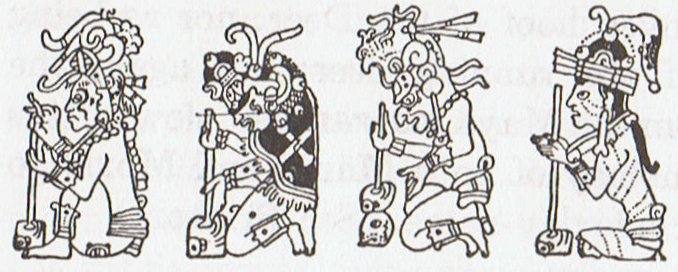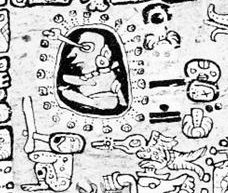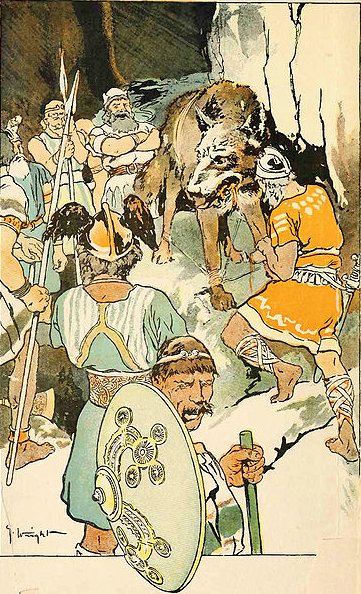Once again. The mythic landscape was an 'implex', by which term is meant a world of implications. ... Fanciful, assuredly, but neither the Milky Way nor the terrestrial Ganges offered any basis for the imagery of a river flowing to the four quarters of the earth 'for the purification of the three worlds'. One cannot get away from the 'implex' and it is now necessary to consider the tale of a new skeleton map, alias skambha: the equinoctial colure had shifted to a position where it ran through stars of Auriga and through Rigel. Skambha, as we have said, was the World Tree consisting mostly of celestial coordinates, a kind of wildly imaginative armillary sphere. It all had to shift when one coordinate shifted ...
The leading character in the G text (I established long ago before considering the role of the stone statue Takapau in Manuscript E) had to be Gb6-26. Because each glyph corresponded to a right ascension day and the glyph distance from Aldebaran to Antares implied it was the days of the northern summer (the southern winter).
In the G text one can find spring equinox (vaha mea, the red opening) in Roman times to be 41 days (glyphs) earlier than spring equinox at the time of the Bull.
Vaha. Hollow; opening; space between the fingers (vaha rima); door cracks (vaha papare). Vahavaha, to fight, to wrangle, to argue with abusive words. Vanaga. 1. Space, before T; vaha takitua, perineum. PS Mgv.: vaha, a space, an open place. Mq.: vaha, separated, not joined. Ta.: vaha, an opening. Sa.: vasa, space, interval. To.: vaha, vahaa, id. Fu.: vasa, vāsaà, id. Niuē: vahā. 2. Muscle, tendon; vahavaha, id. Vahahora (vaha 1 - hora 2), spring. Vahatoga (vaha 1 - toga 1), autumn. 3. Ta.: vahavaha, to disdain, to dislike. Ha.: wahawaha, to hate, to dislike. Churchill.
Which implied Gb6-26 was at right ascension day *0 according to the epoch of rongorongo:
For although the precessional time depth from the epoch of rongorongo down to that of the Golden Age of the Bull was *64 right ascension days and the corresponding measure down to Roman times was *27 it was necessary to add *4 days because this was implied from how the Pope Gregory XIII had shifted the date for the northern spring equinox from day 84 to day 80. Whereas the date for the northern autumn equinox (southern spring equinox) had been left unchanged.
... When Julius Caesar established his calendar in 45 BC he set March 25 as the spring equinox. Since a Julian year (365.25 days) is slightly longer than an actual year the calendar drifted with respect to the equinox, such that the equinox was occurring on about 21 March in AD 300 and by AD 1500 it had reached 11 March. This drift induced Pope Gregory XIII to create a modern Gregorian calendar. The Pope wanted to restore the edicts concerning the date of Easter of the Council of Nicaea of AD 325. (Incidentally, the date of Easter itself is fixed by an approximation of lunar cycles used in the Hebraic calendar, but according to the historian Bede the English name 'Easter' comes from a pagan celebration by the Germanic tribes of the vernal - spring - equinox.) So the shift in the date of the equinox that occurred between the 4th and the 16th centuries was annulled with the Gregorian calendar, but nothing was done for the first four centuries of the Julian calendar. The days of 29 February of the years AD 100, AD 200, AD 300, and the day created by the irregular application of leap years between the assassination of Caesar and the decree of Augustus re-arranging the calendar in AD 8, remained in effect. This moved the equinox four days earlier than in Caesar's time ... ... These '4 unneccessary leap days' (prior to the Council of Nicaea) were approximately equal in number to the precessional distance in time between the Pope and the time of rongorongo. The Gregorian calendar could therefore be easily understood by the Easter Islanders. The Pope had created a 'crooked calendar' but since his time the precession had fixed it. ... Looking forward, Taetagaloa is right, the canoe is crooked. He slices through all the lashings of the canoe to straighten the timbers. He realigns the timbers. First he must again position the supports, then place the timbers correctly in them, but Kuikava the son of Likāvaka goes over and stands upon one support. His father Likāvaka rushes right over and strikes his son Kuikava with his adze. Thus Kuikava dies. Taetagaloa goes over at once and brings the son of Likāvaka, Kuikava, back to life. Then he again aligns the supports correctly and helps Likāvaka in building the canoe. Working working it is finished ... The place of Sirrah was at the 'topknot' of Andromeda, the corner of the Pegasus Square which was regarded as the Navel of the Horse:
... Maui was the fifth and youngest of his parents' sons, yet when he was born his brothers knew nothing of it. They first learned that they had a brother when he was discovered one night standing behind them in the great meeting house. Everyone was present, the four brothers, their mother Taranga, and all the relations, and there was dancing going on, when little Maui crept into the house unseen, and went and sat behind his brothers. When it came to their turn to dance, and their mother stood them up and counted them so as to be ready, he stood up with them. Tara. 1. Thorn: tara miro. 2. Spur: tara moa. 3. Corner; te tara o te hare, corner of house; tara o te ahu, corner of ahu. Vanaga. (1. Dollar; moni tara, id.) 2. Thorn, spike, horn; taratara, prickly, rough, full of rocks. P Pau.: taratara, a ray, a beam; tare, a spine, a thorn. Mgv.: tara, spine, thorn, horn, crest, fishbone. Mq.: taá, spine, needle, thorn, sharp point, dart, harpoon; taa, the corner of a house, angle. Ta.: tara, spine, horn, spur, the corner of a house, angle. Sa.: tala, the round end of a house. Ma.: tara, the side wall of a house. 3. To announce, to proclaim, to promulgate, to call, to slander; tatara, to make a genealogy. P Pau.: fakatara, to enjoin. Mq.: taá, to cry, to call. 4. Mgv.: tara, a species of banana. Mq.: taa, a plant, a bird. Ma.: tara, a bird. 5. Ta.: tara, enchantment. Ma.: tara, an incantation. 6. Ta.: tara, to untie. Sa.: tala, id. Ha.: kala, id. Churchill. The suffix -nga in Taranga probably indicated plural - thorns:
'One, that's Maui mua; two, that's Maui roto; three, that's Maui taha; four, that's Maui pae', she said; these names mean Maui the first, Maui the middle, Maui the side, and Maui the edge. Then she saw this other child standing with them, and cried out, 'Hullo, where did this one come from?' 'I'm your child too', Maui replied. So she counted them again and said, 'Oh no, there ought to be only four of you. This is the first I've seen of you.' And so there was a scene, with little Maui and the old woman arguing about it in the middle of the rows of dancers. In the end she became annoyed with him. 'Now, come on, out of the house!' she said. 'You are no child of mine, you belong to someone else. Go home!' But little Maui stood up for himself. 'Well then, I'd better go, I suppose', he said. 'Since you say so, I must be someone else's child. But I did think I was yours, because I know I was born at the edge of the sea, and you cut off a tuft of your hair and wrapped me in it and threw me in the waves. After that the seaweed took care of me and I drifted about in the sea, wrapped in long tangles of kelp, until a breeze blew me on shore again, and some jelly-fish rolled themself around me to protect me on the sandy beach. Clouds of flies settled on me and I might have been eaten up by the maggots; flocks of seabirds came, and I might have been pecked to pieces. But then my great-ancestor Tama nui ki te rangi arrived. He saw the clouds of flies and all the birds, and he came and pulled away the jelly-fish, and there was I, a human being! Well, he picked me up and washed me and took me home, and hung me in the rafters in the warmth of the fire, and he saved my life. And I grew, and eventually I heard about the dancing you have here in this house, and that is what brought me here tonight.' Now Taranga listened to all this in amazement. For in the custom of our people, if a child was born before it finished growing in its mother's womb and died without knowing any of the pleasures of life, it was supposed to be buried with special prayers and ceremonies, otherwise it became a kind of evil spirit, always doing mischief to the human race and hurting them out of spite, because of having missed the happiness that they enjoy. All the evil spirits had a beginning of this sort. So Maui was a little demi-god of mischief. The story he had told was true, and as his mother listened she remembered it all. 'From the time I was in your womb,' Maui went on, 'I have known the names of these children of yours. Listen,' he said as he pointed to his brothers in turn. 'You are Maui mua, you are Maui roto, you are Maui taha, and you are Maui pae. And as for me, I am Maui potiki, Maui-the-last-born. And here I am.' When he had finished, Taranga had to wipe her eyes because there were tears in them, and she said: 'You are indeed my lastborn son. You are the child of my old age. When I had you, no one knew, and what you have been saying is the truth. Well, as you were formed out of my topknot you can be Maui tikitiki a Taranga.' So that became his name, meaning Maui-formed-in-the-topknot-of-Taranga. And this is very strange, because women in those days did not have topknots. The topknot was the most sacred part of a person, and only men had them ...
All this implies we should count from the December solstice (day 355), because then Sirrah (the Topknot of Taranga) would become day 91, corresponding to the measure of his 4 brothers. 366 - 355 + 80 = 91:
... The Maori word for 'the front of' is mua and this is used as a term to describe the past, that is, Nga wa o mua or the time in front of us. Likewise, the word for the back is muri which is a term that is used for the future. Thus the past is in front of us, it is known; the future is behind us, unknown. The point of this is that our ancestors always had their backs to the future with their eyes firmly on the past ... Va. 1. Hakava, judge, judgement. T Mgv.: akava, to judge, to pass sentence. Pau.: haava, to judge, to conjecture. Ma.: whakawa, to charge with crime, to condemn. Ta.: haava, to judge. 2. Hakava, to speak. P Mgv.: va, to speak. Mq.: vaa, to chatter like a magpie. The Marquesan retains more of the primal sense although the simile is an alien importation. In Samoa va means a noise, in Tonga va is a laughing noise, in Futuna va is the disorderly cry of tumult, and probably it is the initial element of Viti wa-borabora to speak quickly and confusedly as when scolding. Its only identification in Tongafiti territory is Hawaii wawa the confused noise of a tumult ... Churchill. Ta.: va, space between the leaves in a roof. Sa.: va, space between. Ma.: wa, interval. Churchill.
Furthermore, in order to increase the day numbers with 91 - 80 = 11 we should shift the point of reference from Sirrah (*0) to that of η Andromedae (*11), a star which remarkably had gone down to the Fishes (Pisces):
Which implies a corresponding shift in dates from March 21 (80) to April 1 (91):
January 1 was 11 days after the solstice and therefore the next quarter should begin with April 1 = 11 days after the Gregorian equinox. Between the place for the stone statue named Te Takapau and April 1 it was thus reasonable to place 10 tara (→ Tara-nga) variants of uhi. I am using the sign → in order to say 'implies'. The Chinese recognized April 1 as a cardinal point in time, and their 15th station was named Legs with the added clue Wolf. This was probably intended to indicate a contrast to the following 16th station named Bond with the clue Dog.
The glyph design of Gb7-9 suggests a contrast to that of the preceding glyph. That is, a sign of 'no fire' ('darkness', 'death'). ... In China, every year about the beginning of April, certain officials called Sz'hüen used of old to go about the country armed with wooden clappers. Their business was to summon the people and command them to put out every fire. This was the beginning of the season called Han-shih-tsieh, or 'eating of cold food'. For three days all household fires remained extinct as a preparation for the solemn renewal of the fire ...
We have to add 16 right ascension days (approximately corresponding to 16º) in order to once again see the star η Andromedae in the late morning sky, after its close encounter with the blinding rays from the Sun: ... their separation from the sun is just beyond the minimum distance 16° that a star may be from the sun and still be visible ... ... The eye is the symbolic site of subjection. Valeri observes that: 'The two sentiments that permit the transcendence of the self are, according to Hawaiians, desire and respect. One and the other are called kau ka maka, literally, 'to set one's eyes on' ... 'To see' (ike) in Hawaiian (as in French or English) is 'to understand', but it is also 'to know sexually'. Witness to the order, the world of forms generated by the chief, the eye, is the sacrifice of those who violate that order. The left eye of the slain tabu-transgressors is swallowed by Kahoali'i, ceremonial double of the king and living god of his sacrificial rites. Like the sun, chiefs of the highest tabus - those who are called 'gods', 'fire', 'heat', and 'raging blazes' - cannot be gazed directly upon without injury. The lowly commoner prostrates before them face to the ground, the position assumed by victims on the platforms of human sacrifice. Such a one is called makawela, 'burnt eyes'.
In order to fetter the Wolf, to bind him and to convert him into a peaceful Dog, someone had to lure him with a piece of flesh. This explains the name for the 11th yam species, for makere means 'to die'.
|
|||||||||||||||||||||||||||||||||||||||||||||||||||||||||||||||||||||||||||||||||||||||||||||||||||||||||||||||||||||||||||||
